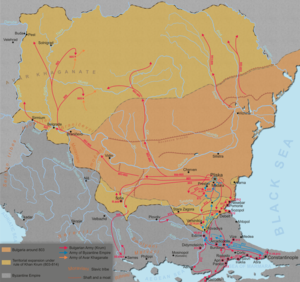The 800s decade ran from January 1, 800, to December 31, 809.

Abū Jaʿfar Hārūn ibn Muḥammad ar-Rāshīd, or simply Hārūn ibn al-Mahdī, famously known as Hārūn ar-Rāshīd, was the fifth Abbasid caliph of the Abbasid Caliphate, reigning from September 786 until his death in March 809. His reign is traditionally regarded to be the beginning of the Islamic Golden Age. His epithet al-Rashid translates to "the Orthodox", "the Just", "the Upright", or "the Rightly-Guided".

Abū Mūsā Muḥammad ibn Hārūn al-Amīn, better known by his laqab of al-Amin, was the sixth Abbasid caliph from 809 to 813.

Abū al-ʿAbbās Abd Allāh ibn Hārūn al-Maʾmūn, better known by his regnal name al-Ma'mun, was the seventh Abbasid caliph, who reigned from 813 until his death in 833. He succeeded his half-brother al-Amin after a civil war, during which the cohesion of the Abbasid Caliphate was weakened by rebellions and the rise of local strongmen; much of his domestic reign was consumed in pacification campaigns. Well educated and with a considerable interest in scholarship, al-Ma'mun promoted the Translation Movement, the flowering of learning and the sciences in Baghdad, and the publishing of al-Khwarizmi's book now known as "Algebra". He is also known for supporting the doctrine of Mu'tazilism and for imprisoning Imam Ahmad ibn Hanbal, the rise of religious persecution (mihna), and for the resumption of large-scale warfare with the Byzantine Empire.

Abū Muḥammad Mūsā ibn al-Mahdī al-Hādī better known by his laqab al-Hādī (الهادي) was the fourth Arab Abbasid caliph who succeeded his father al-Mahdi and ruled from 169 AH until his death in 170 AH. His short reign ended with internal chaos and power struggles with his mother.

The Barmakids, also spelled Barmecides, were an influential Iranian family from Balkh, where they were originally hereditary Buddhist leaders, and subsequently came to great political power under the Abbasid caliphs of Baghdad. Khalid, the son of Barmak became the chief minister (vizier) of Al Saffah, the first Caliph of the Abbasid dynasty. His son Yahya aided Harun al-Rashid in capturing the throne and rose to power as the most powerful man in the Caliphate.

Yahya ibn Khalid was the most prominent member of the Barmakid family, serving as provincial governor and all-powerful long-time vizier to Caliph Harun al-Rashid before his abrupt fall in 803.

Musa ibn Yahya was a member of the powerful Barmakid family in the service of the Abbasid Caliphate.

The Battle of Krasos took place during the Arab–Byzantine Wars in August 804, between the Byzantines under Emperor Nikephoros I and an Abbasid army under Ibrahim ibn Jibril. Nikephoros' accession in 802 resulted in a resumption of warfare between Byzantium and the Abbasid Caliphate. In late summer 804, the Abbasids had invaded Byzantine Asia Minor for one of their customary raids, and Nikephoros set out to meet them. He was surprised, however, at Krasos and heavily defeated, barely escaping with his own life. A truce and prisoner exchange were afterwards arranged. Despite his defeat, and a massive Abbasid invasion the next year, Nikephoros persevered until troubles in the eastern provinces of the Caliphate forced the Abbasids to conclude a peace.
Ibrāhīm ibn al-Mahdī was an Abbasid prince, singer, composer and poet. He was the son of the third Abbasid caliph, al-Mahdi, and the half-brother of the poet and musician Ulayya. Ibrahim was contemporary of Abbasid caliph al-Hadi, al-Rashid and his three nephews caliph al-Amin, al-Ma'mun, al-Mu'tasim.
Zubaidah bint Ja`far ibn al-Mansur was the best known of the Abbasid princesses, and the wife and double cousin of Harun al-Rashid. She is particularly remembered for the series of wells, reservoirs and artificial pools that provided water for Muslim pilgrims along the route from Baghdad to Mecca and Medina, which was renamed the Darb Zubaidah in her honor. The exploits of her and her husband, Harun al-Rashid, form part of the basis for The Thousand and One Nights.

The 806 invasion of Asia Minor was the largest of a long series of military operations launched by the Abbasid Caliphate against the Byzantine Empire. The expedition took place in southeastern and central Asia Minor, where the two states shared a long land border.
Al-Qāsim ibn Hārūn ar-Rāshīd ibn Muḥammad al-Mahdī was an Abbasid prince, the third son of the Abbasid caliph Harun al-Rashid, and for a time third-in-line to the Abbasid throne.
Abbasa bint al-Mahdi was a famous Abbasid princess. She was the daughter of Abbasid caliph al-Mahdi, sister of caliph Musa al-Hadi and Harun al-Rashid.
Yaḥyā ibn ʿAbd Allāh ibn al-Ḥasan ibn al-Ḥasan ibn ʿAlī ibn Abī Ṭālib was an Alid and Zaydi leader who led a rebellion against the Abbasid caliph Harun al-Rashid in Daylam in 792. He was soon obliged to capitulate, but his activity began the spread of Zaydi Islam in the remote mountains of Daylam. After his surrender, he was initially treated with much honour, but Harun remained deeply suspicious of his popularity and intentions, and recalled him to Baghdad, where he spent the remainder of his life in prison. In 802, the Barmakid Ja'far ibn Yahya helped him escape, but he was captured; the event led to the execution of the Barmakids, once Harun's closest companions. Yahya died in prison, probably in 803.
Muhammad ibn Khalid ibn Barmak was one of the Barmakids, a family of Iranian functionaries who rose to great power under the Abbasid caliph Harun al-Rashid.
Qaratis, also known as Umm Harun or Umm al-Wathiq was the umm walad of the eighth Abbasid caliph al-Mu'tasim, and mother of his successor, al-Wathiq.
Lubābah bint Jaʿfar was an Abbasid princess, granddaughter of second Abbasid caliph al-Mansur, niece of third Abbasid caliph al-Mahdi and the principal wife of fourth Abbasid caliph al-Hadi.
Umm Muḥammad bint Ṣāliḥ was an Abbasid princess, niece of third Abbasid caliph al-Mahdi and wife of caliph Harun al-Rashid.
Abbasa bint Sulayman was an Abbasid princess, daughter of Sulayman ibn Abi Ja'far, niece of Abbasid caliph al-Mahdi and wife of caliph Harun al-Rashid.







